
|
![]()
Greatest Films of the 1950s
1950 | 1951 | 1952 | 1953 | 1954 | 1955 | 1956 | 1957 | 1958 | 1959
Title Screen Film Genre(s), Title, Year, (Country), Length, Director, Description 


An Affair to Remember (1957), 115 minutes, D: Leo McCarey
Director Leo McCarey's romantic tearjerker melodramatic tale of star-crossed lovers was a CinemaScopic remake of McCarey's original shipboard romance classic Love Affair (1939), starring Irene Dunne and Charles Boyer. It was also referenced in director Nora Ephron's Sleepless in Seattle (1993) and in Love Affair (1994) with Warren Beatty and Annette Bening. In the film's early scenes, at the end of a transatlantic ocean cruise (from Europe to New York) before their ship USS Constitution docked in NYC, wealthy playboyish bachelor (and talented painter) Nickie Ferrante (Cary Grant) and former nightclub singer Terry McKay (Deborah Kerr) had formed a strong friendship; however, the two were both involved with other relationships: Nickie was soon to marry his lovely, wealthy celebrity fiancée Lois Clarke (Neva Patterson) - a rich heiress, and Terry had a long-time boyfriend named Kenneth Bradley (Richard Denning). Nonetheless, the two decided to reunite six months later (on July 1st at 5:00 pm) at the top (102nd floor) of the Empire State Building, as Terry added: "Oh yes, that's perfect. It's the nearest thing to heaven we have in New York." Six months later when Nickie waited at their rendezvous point (a clock chimed 5 times), Terry didn't appear (she was injured in an awful car accident (off-screen) on a busy NYC street on her way rushing to meet him) and there were ambulances heard blaring at 10 minutes after five. Nickie assumed that he had been rejected and subsequently resumed his painting career. Although disabled, Terry took work as a music teacher for orphaned children. In the conclusion of the tale, there came a startling revelation scene six months later on Christmas Eve - regarding the devastating, terrible secret of why she couldn't keep her fateful appointment with him atop the Empire State Building - he visited her in her apartment as she remained unmoving and supine on a couch (he was unaware of her injury); he delivered an accusatory and scolding conversation with her. Nickie gave Terry a Christmas present of a shawl from his now-deceased Grandmother Janou (Cathleen Nesbitt) [Note: Earlier, during their ship's docking at Madeira, Nickie and Terry took a sidetrip to his grandmother's hillside villa. At their departure, the Grandmother promised to send Terry her beautiful white lace shawl one day.] As he was leaving after they diplomatically shook hands, he casually mentioned that he had once painted a picture similar to the way she looked: "You know, I painted you like that with the shawl. I wish you could have seen it...I didn't think I could ever part with it. But well, there was no reason to keep it any longer, and, uh, I couldn't take money for it, because, well, you know.." He had agreed to have the painting given away free to a woman in a wheelchair who liked it, but had no money - "She was..." - and then suddenly, he became suspicious about why Terry was immobile on the couch, paused and went into the adjoining bedroom. In Terry's bedroom, he discovered that she was the one who had acquired his painting - it was hanging on the wall (visible when the camera slowly panned right to show the painting's mirror reflection in the room) - she was the recipient of his painting! and had kept her accident a secret. After returning to the living room, Nickie stared disbelieving at Terry, who requested: "Darling, don't look at me like that"; he had made the ultimate discovery and deduction by inferring the devastating, terrible secret of how fate had intervened on the day they were to meet - he asked: "Why didn't you tell me? If it had to happen to one of us, why did it have to be you?" With a tearful hug, she explained: "It was nobody's fault but my own. I-I was looking up. It was the nearest thing to heaven. You were there. Oh, darling, don't, don't worry, darling. If you can paint, I can walk. Anything can happen. Don't you think?" He wiped away her tears and replied: "Yes, darling, yes. Yes, yes, yes"; they kissed, and a chorus sang atop a snowy view of New York City: "Our Love Affair To Remember" as the film concluded.
The Bachelor Party (1957), 92 minutes, D: Delbert Mann
Scriptwriter Paddy Chayefsky adapted his own 1953 teleplay (airing on The Philco Television Playhouse) for this feature-length male angst drama - an ensemble film. The intimate film told about the loneliness, insecurities, anxieties and frustrations of five middle-class, co-working male bookkeepers. At first glance, they appeared to be debonair and carefree. They held a bachelor party in a restaurant for thirtyish, timid and virginal Arnold Craig (Philip Abbott), who was about to be married to a war widow. The group included: protagonist Charlie Samson (Don Murray), older married asthma-suffering Walter (E.G. Marshall), swinging bachelor Eddie Watkins (Jack Warden), and henpecked married man Kenneth (Larry Blyden). During the party and night-clubbing/bar-hopping later on in the evening, all the characters began to reflect on their lives, concerns and issues about love and marriage. Staid, hard-working, struggling married man Charlie had second thoughts about his own marital ties (with newly-pregnant wife Helen (Patricia Smith)) - he felt trapped, restless and bored, and maybe not ready for fatherhood. The troubled Charlie was tempted to have a one-night affair with a young, footloose 'good-time-girl' bohemian - credited as the Existentialist (Oscar-nominated Carolyn Jones), whom he met on the way to Greenwich Village. After a few drinks, Walter revealed himself as a pathetic, despairing and self-loathing hypochondriac, who was sacrificing his health to keep his boy in school. The nervous groom-to-be Arnold also became ambivalent and fearful about his impending marriage and called off the nuptials (although he sobered up and changed his mind), and desperate bachelor Eddie (who was initially envied for his carefree, lady-killing existence) was still alone and struggling to pick up a woman at the bar.



The Bridge on the River Kwai (1957), 161 minutes, D: David Lean
Director David Lean's spectacular, acclaimed, all-time great WWII epic drama, and Best Picture-winning film was about British P.O.W.'s forced to construct a railway bridge over the River Kwai in the Asian jungle of Burma to connect a rail-line from Bangkok to Rangoon. The anti-war film was based on an outstanding, psychologically complex adaptation of Pierre Boulle's 1952 novel. In its opening, British soldiers arrogantly marched into the sweltering jungle prison camp to the whistling tune of the "Colonel Bogey March." The prisoner-soldiers were led by an obstinate commander Col. Nicholson (Alec Guinness), and ordered to build a rail bridge by the camp commander Col. Saito (Sessue Hayakawa). They would unwittingly aid the war effort of their Japanese captors. Through the film, an antagonistic battle leading to a standoff existed between the two stubborn wills of indomitable British Colonel Nicholson and the Japanese Colonel Saito, about whether officers should work along with the other men - after Nicholson called his attention to Article 27 of the Geneva Convention. Ultimately, Nicholson was allowed to take charge of supervising the bridge's construction, and he established a twisted sense of pride in his fortified creation to show up the Japanese as inferior. Major Clipton (James Donald) questioned Nicholson's objectives: "Must we build them a better bridge than they could have built for themselves?" In the suspenseful finale, Nicholson discovered dynamite wires that had been secretly planted by his Allied (British and American intelligence) forces to blow up the structure, led by cynical American ex-prisoner and heroic escapee Commander Shears (William Holden) and British commando Major Warden (Jack Hawkins). Overnight, the water level of the river had fallen and exposed the wires. There was unbearable tension as the Japanese troop train was heard approaching the bridge and the commandos prepared to blow up the bridge. Foolishly, Nicholson attempted to save his bridge, and then uttered his moral dilemma ("What have I done?"), and fell lethally-wounded on the dynamite plunger. The question arose: Had he deliberately fallen on the plunger or was it accidental? The railroad bridge and the train were climactically destroyed, with the film's final words spoken by Clipton: "Madness...madness, madness."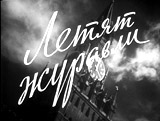



The Cranes Are Flying (1957, Soviet Union) (aka Letyat Zhuravli, or Летят журавли), 97 minutes, D: Mikhail Kalatozov
This realistic, post-Stalin Soviet romantic melodrama about the effects of World War II on a blissful, loving couple in the Soviet Union won the Grand Prize (Palme d'Or) at the Cannes Film Festival in 1958. The expressionistic B/W cinematography was beautifully realized, with stunning, mobile hand-held 35 mm camera shots. The plotline, based on a play by Viktor Rusov, was set in Moscow in 1941 at the time of the sudden German invasion of Russia. Its title came from the opening sequence in which the two protagonists, engaged lovers Veronika (Tatyana Samoylova) and young engineering student Boris Fyodorovich Borodin (Aleksey Batalov), watched as cranes ascended into the sky at sunrise. When they returned to their apartments after their secret rendezvous, with plans to return to the river bank, the patriotic-minded, responsible-minded factory worker Boris joined the army and was immediately deployed to the front. It was the day before Veronika's birthday, and he was unable to say goodbye to her. However, he left her a stuffed squirrel toy ("squirrel" was Boris' endearing nickname for Veronika) in a basket with a love-note inside as a birthday gift. [Note: Veronika did not see the farewell love note that ended with Boris' affirmation: "...But we'll be happy yet. I love you. I have faith in you. Yours, Boris.] During the war, Veronika was devastated when a German air-raid destroyed her home and killed her parents. The orphaned Veronika was offered to live with Boris' family by Boris' physician father Fyodor Ivanovich Borozdin (Vasiliy Merkurev). During a Nazi air raid, Boris' forceful cousin, concert pianist Mark Aleksandrovich Borozdin (Aleksandr Shvorin), who was angry after being rebuffed by Veronika, raped her. Soon after, the exhausted, emotionally-broken and vulnerable Veronika made the fateful decision to marry Mark, although they despised each other and were miserable together, and Boris' family thought Veronika had betrayed Boris who was by now considered missing-in-action. On the war front, Boris saved a fellow soldier named Volodya (Konstantin Kadochnikov), but was lethally wounded and died while having an unfulfilled vision of a wedding to Veronika. The Borozdin family was forced to flee and relocate in Siberia, where Veronika worked as a wartime-nurse in an overcrowded military hospital managed by Boris' father. In the hospital, Veronika listened as injured soldier Volodya spoke judgmentally about unfaithful women who gave up their relationships during the war. She became overwhelmed with guilt that she had abandoned Boris and was unworthy of him. The self-loathing Veronika threatened suicide by jumping off a railway bridge, but was saved by the act of selflessly rescuing a young child (named Boris!) about to be hit by a car. Veronika went to retrieve Boris' toy squirrel gift to amuse the young boy at a party held by her promiscuous husband Mark for his mistress. She discovered the love note written by Boris to her. Fyodor learned of Mark's true lack of character as a no-good, cheating and draft-dodging husband, who had used bribes to avoid being drafted into the Soviet Army, and also had abused Veronika. As a result, Mark was thrown out, and Veronika's reputation was rehabilitated and restored. The young boy became part of her family. During the film's ending once the war had ended in 1945, and Veronika had returned to live in Moscow, she received confirmation at the train station - where troops on Victory Day were returning - that Boris had indeed died during combat. She offered flowers from her bouquet to the military families and their loved ones. A sign that better times were on the horizon was signaled by the return of cranes flying in formation over Moscow, rather than "birds of war." The film concluded with a speech delivered by Boris' friend Stepan (Valentin Zubkov): "...But we shall not forget those left behind on the battlefield. Time will pass. Towns and villages will be rebuilt. Our wounds will heal. But our fierce hatred of war will never diminish. We share the grief of those who cannot meet their loved ones today, and we will do everything to insure that sweethearts are never again parted by war, that mothers need never again fear for their children's lives, that fathers need never again choke back hidden tears. We have won, and we shall live not to destroy, but to build a new life!"

A Face in the Crowd (1957), 125 minutes, D: Elia Kazan
Director Elia Kazan's powerful and satirical political drama illustrated how a jailed, down-home country boy in the late 1950s could be transformed overnight into a media celebrity on the radio, and later become a mean-spirited political demagogue and megalomaniac on TV. In the opening sequence, Larry "Lonesome" Rhodes (Andy Griffith in his film debut) - an opportunistic, smiling, drunken cornpone-spouting, back country homeless man, was first heard strumming his bluesy guitar in a rural jail-cell, in the fictional town of Pickett in northeast Arkansas. He had been taken in the previous night for being "drunk and disorderly." KGRK radio reporter/producer Marcia Jeffries (Neal) conducted her local radio show ("A Face in the Crowd") from the cell and became transfixed when she heard him sing the home-spun song "Free Man in the Morning." Afterwards, Rhodes was brought to Memphis, Tennessee to appear on TV, and introduced to bookish, well-educated staff writer Mel Miller (Walter Matthau). Soon, the new con-artist/star would be making commercial pitches in New York for a product known as Vitajex - a dietary supplement promoted to increase energy and sexual virility. In a revealing bedroom scene with Marcia, Rhodes revealed his disturbing, arrogant and power-hungry intentions that his audience would sheepishly follow him anywhere, and be directed to wherever he wished: ("They're mine. I own 'em. They think like I do. Only they're even more stupid than I am, so I gotta think for 'em. Marcia, you just wait and see. I'm gonna be the power behind the President, and you'll be the power behind me. You made me, Marcia. You made me. I always say that. I owe it all to you. I owe it all to you."). In a side story, although Rhodes proposed marriage to Marcia, he became infatuated with teenaged, 17 year-old baton twirler Betty Lou Fleckum (Lee Remick in her screen debut), and eloped with her, and then engaged in a 50-50 business partnership with Marcia. On a number of occasions, Rhodes expressed how disrespectful, fraudulent and hypocritical he was. When concluding his national TV show ("The Cracker Barrel"), thinking that his microphone had been cut off (but was deliberately turned back on by Marcia to expose his duplicity), he showed his utter contempt for his mass audience by personally and nastily insulting them as stupid morons. In the stunning conclusion of his inevitable melt-down and spectacular downfall, drunken and delusional rabble-rouser Rhodes was in his swanky hotel two-floor penthouse for a fancy dinner party of political elites, to advance his own political agenda, where he found an empty room attended only by black butlers and servants, and he threatened to commit suicide after being disowned by his previous adoring public. Although Rhodes was finished for the time being, Miller predicted that it might only be a temporary setback.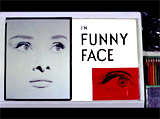


Funny Face (1957), 103 minutes, D: Stanley Donen
Originally, Funny Face was a 1920s stage musical starring Fred Astaire and his sister Adele. When the production eventually reached Broadway in late 1927, it was a tremendous hit. The Stanley Donen-directed 1957 romantic comedy-musical again starred Astaire and featured winning songs by the Gershwins, although the plot was significantly changed. In this iteration, New York City's Quality fashion magazine editor Maggie Prescott (Kay Thompson) (based upon Harper's Bazaar editor Diana Vreeland) and her top fashion photographer Dick Avery (Fred Astaire, about 3 decades older than Hepburn) (based upon Richard Avedon) were looking for a model (a "Quality Woman") who was both beautiful and intellectual. In a small Greenwich Village bookshop ("Embryo Concepts") that was used as a photo backdrop, the mess created during the impromptu and intrusive photo-shoot upset the store's shy, withdrawn and bookish clerk, Jo Stockton (Audrey Hepburn in her first musical). Amateur philosopher Jo revealed her belief in "empathacalism" to Avery, and remained cool to his romantic advances and kisses. Dick was enamoured by Jo's fresh and intellectual look (her "funny face") and promoted her to Maggie, who was in the process of selecting a 'quality' woman to photograph in Paris. Jo reluctantly agreed to go to Paris (mostly to attend a philosophical lecture by her 'idol' - Professor Emile Flostre (Michel Auclair), empathacalism's founder). In addition, she would serve as a model for Paris-based Paul Duval's (Robert Flemyng) designer clothes. In the City of Lights during a touring travelogue of photos for the fashion event, Jo and Dick began to fall in love. Filmed in soft-focus in the green countryside at the Chantilly churchyard near Paris, Jo was photographed in a wedding bridal dress. She confessed her love for him and the two danced: ("He Loves and She Loves"). Ultimately, Jo's interest in Flostre fell apart when he was revealed to be more desirous of her physically than intellectually, and she knocked him over the head with a vase. She then wholeheartedly participated in the magazine's fashion show finale, and was able to reconcile with Dick (who became disconsolate when he thought Jo was no longer interested in him and was ready to leave Paris). In the fairy-tale ending, they again reunited in the garden at the small country church - and sang together "'S Wonderful."


Gunfight at the O.K. Corral (1957), 122 minutes, D: John Sturges
Hollywood's ahistorical version of the Wyatt Earp-Doc Holliday legends, focusing on the years 1879 to 1881, was also dramatized in director Allan Dwan's Frontier Marshal (1939) with Randolph Scott, John Ford's My Darling Clementine (1946) and the more recent Tombstone (1993) and Wyatt Earp (1994). The film's tagline tauted its main feature: "The Wildest Gunfight in the History of the West." It was derived from a screenplay by novelist Leon Uris, and based on a 1954 article in Holiday Magazine titled The Killer by George Scullin. The film opened with sequences set in Dodge City, Kansas and Fort Griffin, Texas, to set up the subsequent action and introduce the characters. After his long career as a legendary lawman, the upright Wyatt Earp (Burt Lancaster) with his love interest - poker gambler Laura Denbow (Rhonda Fleming), moved to Tombstone, Arizona to help clean up the town and help his brother Virgil (John Hudson) - Tombstone's town marshal. Others helping them were Morgan Earp (DeForest Kelley) and the youngest Earp brother James (Martin Milner). Also in Tombstone was Earp's reluctant ally, terminally-ill gambler John "Doc" Holliday (Kirk Douglas) who amused himself in a tempestuous relationship with trampish Kate Fisher (Jo Van Fleet). Complications arose after Kate joined up with powerful thieving cattle rustler Ike Clanton's (Lyle Bettger) wily hired gun Johnny Ringo (John Ireland), and young James Earp was shot and killed during a mistaken-identity ambush. The western concluded with a 5-minute bloodbath shooting at the O.K. Corral - a showdown between the Earps and Clantons. In the film's version, all six in Clanton's gang were killed, including young Billy Clanton (Dennis Hopper) who was given a chance to surrender, but refused.
[Note: In reality, the shootout on October 26, 1881 did not take place in or next to the O.K. Corral, and was over in 30 seconds, with an exchange of 34 bullets, and the deaths of three men: Billy Clanton and two McLaury brothers (Tom and Frank). Virgil, Morgan, and Holliday were wounded. After the stand-off, the Earp Brothers were immediately arrested for murder and put on trial, but were acquitted for acting lawfully.]


The Incredible Shrinking Man (1957), 81 minutes, D: Jack Arnold
Director Jack Arnold's existential, allegorical science-fiction horror film with fantastic special effects told about a shrunken, miniscule human being who had been contaminated and suffered the effects of nuclear radiation and insecticides. He literally became an alien in his own 50's Los Angeles suburban home. The landmark B film of drama and adventure was based on author Richard Matheson's adaptation of his own second novel in 1956 ("The Shrinking Man"), his first screenplay (co-written for the screen by Richard Alan Simmons, who was responsible for removing the novel's flashback structure). In the opening sequence, Robert "Scott" Carey (Grant Williams) was contaminated by exposure to nuclear radiation/waste, when during a vacation off the California coast, his boat came into contact with a strange, misty white cloud above the water and covered his chest with white glittering particles. His wife escaped exposure due to being below deck. Over a period of months, after also being accidentally exposed to a pesticide (a triggering effect), Scott's clothes didn't fit and he gradually began to shrink in size as he lost both weight and stature, compared to his wife Louise Carey (Randy Stuart), and his concerned brother Charlie (Paul Langton). He voiced his issues to family physician Dr. Arthur Bramson (William Schallert), followed by numerous tests at the California Medical Research Institute led by Dr. Thomas Silver (Raymond Bailey). His eventual diagnosis was that the mildly virulent germ-spray insecticide had created a "deadly chemical reversal of the growth process," and it appeared to be irreversible. "Shrinking Man" Scott suggested to Louise that she was free to leave him since he was no longer able to fulfill his manly functions with reduced shape and size: ("There's a limit to your obligation"), exemplified by his wedding ring limply slipping from his finger. Compelled to remain secluded in his home as he kept losing size (and was barely tall enough to look out the living room window), Scott had shrunk to the size of a 5 year-old kid (one-half his adult size at 3 feet). Scott became a fascinating object of media attention and national curiosity; while Louise was becoming upset by the constant attention and lack of privacy. Scott and Louise were overjoyed when a treatment serum was found to check the degenerative process of his disease; after a week of observation, it seemed he had stabilized, but doctors denied that it would reverse his condition, and he would remain 3 feet tall. The relationship between Scott and Louise began to deteriorate, and he admitted that he was driving her away, due to his insecurities and self-hate. One day, he realized in shock that he was continuing to shrink. Weeks later and now only six inches tall, Scott was permanently living in a miniature dollhouse for refuge. Louise left home for a small errand, when Scott was attacked by his now-dangerous house cat Butch (Orangey) and was forced down into his home's basement - he plunged into Louise's sewing basket on the basement floor. When Louise returned and saw a bloody scrap of clothing, she expressed fears that the cat had eaten him, with KIRL TV broadcasting the news (John Hiestand): "From Los Angeles today, a tragic story. The passing of Robert Scott Carey. The report of the death of the so-called Shrinking Man comes from his brother. Carey's death was the result of an attack by a common house cat -- a former pet in the Carey home." For almost the entire second half of the film, Scott now faced and endured numerous challenges and threats to his life and had to discover new resources in order to live in his "basement universe" - now that he was only about 3 inches tall. The dialogue was non-existent except for Scott's narration of his own vulnerable, utterly alone and existential predicament, and the profound meaning and understanding he had of his fragile life. He obtained water from a leaky water heater, and sheltered himself in a matchbox. He unsuccessfully attempted to snatch a piece of stale cheese from a giant mousetrap when he snapped it with the weight of a pointed nail, but the cheese rolled away and dropped through a floor grating. His next major effort was to obtain some moldy dry cake or bread on the top of a wooden crate box, but then he realized that he was facing a daunting enemy and was being hunted - by a giant tarantula-spider. As Louise and Charlie were packing up to permanently vacate the house, Scott was nearly drowned when the bottom of the water heat broke open and a torrent of water began to flood the basement. Both Charlie and Louise were unable to see or hear Scott calling out to them from under the stairs and in the water; Scott held onto a floating pencil to avoid sinking and being swept down the drain. He again faced a continuing competitive and violent "death struggle" with the giant tarantula for the last crumb of cake - the monstrous creature was seen approaching with a close-up of its voracious mouth. He was finally able to impale the threatening creature and kill it from underneath with one of the straight pins from the sewing box. As the film concluded, Scott realized in his newly-diminutive state (now about one inch in height) that he was able to escape the basement vent by slipping through its narrow mesh; he was able to walk in the outdoors, to look up at the dark sky and moon and ponder a new beginning without fear. He delivered a memorable enlightened philosophical speech - an epiphany of sorts - about being infinitesimal and able to merge and become one with God and the universe - he pondered whether there was a divine plan behind all the chaos of his unraveled and uncertain life.

Jailhouse Rock (1957), 96 minutes, D: Richard Thorpe
This great black and white B rock-n-roll film has often been voted as the best, most popular, and most famous of Elvis Presley's musicals (his third film out of over 30 films from the late 50s through the 60s) - the plot even slightly paralleled the rocker's own life. This pre-Army film was filled with Presley classics, especially the wonderfully-choreographed set piece for "Jailhouse Rock," as well as the other memorable numbers including "I Want to Be Free," "Treat Me Nice," "You're So Square (Baby, I Don't Care)," and the two tender ballads: "Young and Beautiful" and "Don't Leave Me Now." In the film's opening, cocky, quick-tempered 19 year-old construction worker Vince Everett (Elvis Presley) was goaded into a bar-room brawl that led to a drunken man's death. Vince was charged with accidental manslaughter and sentenced to serve a one-to-ten year jail term. While in jail, his middle-aged cellmate Hunk Houghton (Mickey Shaughnessy), a washed-up, former veteran country singer serving time for armed robbery, mentored him to learn guitar and sing, and persuaded him to enter the prison's inmate talent show. Vince's raw and untamed performance was broadcast on national television and resulted in tons of fan mail, but the jealous Hunk deceptively withheld the letters from Vince, and convinced him to sign a contract that made them equal partners. During his release from incarceration after 14-months, budding rock star and ex-con parolee Vince learned about Hunk's deception via the warden. Struggling to break into the competitive record business and music industry, at a nightclub, Vince met Peggy Van Alden (Judy Tyler), a promoter for another pop singer named Mickey Alba. After being ripped off by Alba who stole and recorded Vince's single "Don't Leave Me Now" with Geneva Records, Vince decided to form his own record label known as Laurel Records, and he hired attorney Mr. Shores (Vaughn Taylor) to handle the finances. He soon became an overnight sensation with DJ Teddy Talbot's (Dean Jones) promotion of his recording of "Treat Me Nice." Ex-con Vince was also invited to appear in New York on a nationwide NBC-TV variety show to sing his hip-swiveling headlining song: "Jailhouse Rock" set in a stylized jail cell. He delivered an introductory prologue about his life in prison where he had first started singing 'Jailhouse Rock'. Vince reconciled with his former cellmate Hunk, and although their prison contract was deemed worthless, Vince promised to provide Hunk with a fee of 10% of his earnings. After being seduced by the decadent lifestyle of a pop star, however, Vince became rebellious, self-centered, and unwilling to work with Hunk or Peggy, his loyal and pretty girlfriend/talent scout/record promoter. In Hollywood while filming a movie with Climax Studios, Vince fell in love with his conceited, stuck-up leading lady co-actress Sherry Wilson (Jennifer Holden). The mercenary, egotistical Vince considered an offer from Geneva Records to purchase Laurel Records, although Peggy advised him to not sell. During an altercation with Hunk who was defending Peggy, Vince was punched in the neck (voice-box larynx) and temporarily lost his singing voice - endangering his singing career. During his hospitalization and recovery, Vince set his priorities straight. He proclaimed his love for Peggy by singing "Young and Beautiful" to Peggy with his healed voice. [Note: Judy Tyler (formerly Princess Summerfall Winterspring on the Howdy Doody TV show) tragically died in a car crash before the film was released.]


Mother India (1957, India) (aka Bharat Mata), 172 minutes, D: Mehboob Khan
Director Mehboob Khan's melodramatic, nationalistic epic account (three hours in length with numerous musical numbers) told about a poverty-stricken yet courageous peasant woman in India. It was a remake of his own earlier film Aurat (Woman) (1940, India), and a defining Indian film shot with the Gevacolor process. It was also the first film from India to be nominated for an Academy Award in the Best Foreign Film category. Told in the Hindi language (with subtitles), it was a Bollywood story of Indian rural life, motherhood, and good vs. evil that equated a resilient, dutiful, strong and proud peasant woman ("mother figure") with the proud and newly-independent land of India. The film's opening was held at the inauguration of a dam and water pump allowing water to flow into village fields. The ceremony was presided over by an elderly woman named Radha (Nargis), the "Mother India" of the village who held a piece of earth in her hands. This initial sequence set up an extended flashback to her entire adult life - she recalled her past while smelling a flower garland around her neck. In a flashback occurring at the time of Radha's expensive marriage to her farmer husband Shamu (Raaj Kumar) around 50 years earlier, a major issue arose for the rest of Radha's life. The local, evil, crooked, lecherous and deceptive moneylender Sukhilala (Kanhaiya Lal) swindled Radha's mother-in-law at the time of her lavish wedding with a high-interest loan-contract that took three-fourths of her produce. Tragedy struck Radha when her husband lost both his arms in a farm accident - they were crushed by a boulder that he was attempting to move. The long-suffering and courageous heroine Radha was then faced with a predicament - she decided to unselfishly sacrifice herself to care for her family of sons: (1) her younger son - the arrogant, mean, rebellious, irresponsible and spiteful Birju (Sunil Dutt), and (2) her elder son - the devoted, sober, responsible and calm Ramu (Rajendra Kumar) [Note: A third son died in infancy.] Due to Shamu's tragic accident and growing debts and starvation, the disabled, humiliated, and shamed Shamu abandoned his family. He disappeared into the night and never returned (and presumably died). Radha was seen pulling the plow (as a plow animal) when the cow died, and she was forced to dig in the mud to find food. A massive storm and flood brought starvation and devastation to the village. To save her children, Radha supplicated herself by submitting herself to moneylender Sukhilala, but due to her ultimate pride and honor, she beat off his advances and refused to offer sex (and marriage to him) in exchange for food, in order to keep both her integrity and chastity. There were tragic consequences: Radha's enraged younger son Birju vengefully attacked moneylender Sukhilala and his daughter Rupa (Chanchal), and was subsequently excommunicated from the village. Birju became a roaming, anarchist bandit who returned on the wedding day of Sukhilala's daughter Rupa - he stabbed Sukhilala to death in the chest and kidnapped the daughter. Consequently, Radha confronted Birju for his undisciplined immorality, and with a shotgun, aimed and shot at him as he rode off on horseback with the captive daughter Rupa in his arms. Radha ran to him, held him as he stumbled towards her, and comforted him as he bloodily died in her arms. In the final image, Radha's bloody hands that were embracing a dying Birju dissolved back to the film's opening - the inauguration of a newly-constructed irrigation canal - where bloody-red water was released down a sluice-way to irrigate the crops.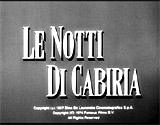


Nights of Cabiria (1957, It./Fr.) (aka Le Notti Di Cabiria), 110 minutes, D: Federico Fellini
Co-writer/director Federico Fellini's romantic melodrama, with a wonderful musical score by Nino Rota, won the Best Foreign Language Film Oscar awarded in 1958. [Note: Fellini's La Strada (1954, It.), also starring Giulietta Masina (Fellini's wife), won the inaugural Best Foreign Language Film Oscar awarded in 1956.] The 1966 Broadway stage musical Sweet Charity directed and choreographed by Bob Fosse (and Fosse's feature film directorial debut and adaptation Sweet Charity (1969) with Shirley MacLaine) both paid homage to Fellini's plot-line. The principal title character of the post-war Italian neo-realistic film was Maria 'Cabiria' Ceccarelli - a waifish, short-statured, optimistic-minded, naive, overly-trusting, independent street-walking prostitute in the city of Rome, who sought clients in the Passeggiata Archeologica of Rome's Parco di Porta Capena. The isolated and disgraced outcast was often wearing a striped blouse, a ratty fake fur jacket and ankle bobby socks. [Note: Her movements and actions recalled Charlie Chaplin's comic Little Tramp character.] In the film's playful opening, Cabiria unexpectedly became the victim of her live-in client-lover (and pimp) Giorgio (Franco Fabrizi), who stole her purse with 40,000 lire and nearly drowned her in a canal. It was the first of many similiar humiliations and degradations that the heroine would experience in various episodes or vignettes as she went on a personal odyssey to search for true love. One night while outside a nightclub in the Via Veneto, the starstruck Cabiria met jaded and recently-jilted movie star Alberto Lazzari (Amedeo Nazzari), who after dancing the mambo with her at a different club, invited her to his palatial house. Upon the return of Lazzari's glamorous, irritated girlfriend to the mansion later that evening, Cabiria (hidden and locked in the bathroom with the dog) watched as Alberto reconciled with her after their earlier argument at the club. That evening, she observed a nameless "Man with the Sack" (Leo Catozzo) - a saintly 'good samaritan' feeding and providing for vagrants and poverty-stricken cave dwellers, including one of Cabiria's elderly and once-beautiful ex-colleagues - it was a possible premonition of her own coming fate. A few days later during a religious pilgrimage and church mass with other prostitutes and pimps at the Shrine of Divine Love, she prayed to a statue of the Virgin Mary, vainly hoping for a better life ("Madonna, Madonna, help me to change my life. Bestow your grace on me too. Make me change my life"). During a magic show in a vaudeville theatre, the drunk Cabiria was called upon by the magician-wizard (Aldo Silvani) to be hypnotized on stage. Introduced to an invisible suitor named Oscar, she became the object of heckling and ridicule from the audience about her desired wish to be married to someone who truly loved her. An accountant named Oscar D'Onofrio (François Périer) who witnessed the show, was sympathetic to her plight. After getting to know each other better and he proposed, Cabiria fell in love with Oscar and announced plans to marry him in two weeks. Her streetwalker friend Wanda (Franca Marzi) cautioned her about selling her shack-house and belongings, and withdrawing all of her money (700,000 lire, her dowry) from her bank account. Cabiria became suspicious of Oscar's ruthless and dishonorable motives when his attitude changed during a walk in a wooded forest with high cliffs above a lake. When she realized his true intentions, she threw her money at him, begged to die, and was left writhing on the ground covered in dead leaves and dirt as he stole her purse and abandoned her. After being devastated and humiliated once again, as Cabiria returned to town, she encountered teenaged revelers happily forming a circus-like parade as they danced and played music. In the film's redemptive coda, the ever-hopeful and undefeated Cabiria - with her spirits lifted - joined the impromptu group and gave a transcendent, hopeful and bittersweet teary smile - the last image was of a single black tear falling from her left eye.


The Pajama Game (1957), 101 minutes, D: George Abbott, Stanley Donen
Stanley Donen and Broadway stage director George Abbott co-directed this likeable, enthusiastically-performed late 50s Warners' musical, based upon the 1953 novel 7 1/2 Cents by Richard Bissell and the earlier Tony Award-winning Broadway show (co-directed by George Abbott and Jerome Robbins). It opened in 1954 (and played through 1959) and won the Tony Award in 1955. Over a third of the cast were retained from the original Broadway show, including eleven of the play's fifteen songs - resulting in the faithful retention of much of the flavor, freshness, and originality of the hit musical. John Raitt was retained from the stage version, but lead female Doris Day replaced Janis Paige. The film's taglines were: "This little old world wouldn't be the same without that extra special fun of The Pajama Game," and "ALL THE BOY-CHASES-GIRL-CHASES-BOY ENTERTAINMENT OF THE RECORD-SMASHING BROADWAY HIT SENSATION!" The career-defining, imaginative dancing sequences (with beautiful set designs) were staged by legendary choreographer Bob Fosse, who worked on both the stage play (his choreographic debut) and film versions. The follow-up Abbott/Donen film Damn Yankees! (1958), their second Broadway adaptation, again featured Fosse's striking choreography. The predictable plotline was about a challenging romance that developed between two individuals who worked at Cedar Rapids Iowa's Sleep-Tite Pajama Factory. The two potential lovers were Katie (or Katherine) "Babe" Williams (Doris Day), the feisty workers' union representative of textile workers who served as the chair of the union's grievance committee, and Sid Sorokin (John Raitt), the new factory shop superintendent who was hired by the factory's cheap-minded executive-manager Myron "Old Man" Hasler (Ralph Dunn) to oppose the workers' demand for a pay raise. Conflict arose between the two during a 7.5 cents an hour pay raise dispute (at the time, calculated to be a 6% pay increase) and jeopardized their romance. One of Babe's strategies was to have the union orchestrate a work slow-down to bring further pressure, although it led to her firing by Sid. She continued to resist, and instituted further strategies to sabotage the sewing of the PJs. The show-stopping hit song Hernando's Hideaway was the name of a local forbidden hot-spot/joint for secret rendezvous. In the resolution of the plot, Sid took Hasler's office secretary-sexpot Gladys Hotchkiss (Carol Haney) to the hideaway, got her drunk, and was able to persuade her to give him the key to her manager's locked account book. Sid learned that the manager had reported that the pay raise had already been instituted months ago, but he had been corruptly pocketing the profitable difference. Sid was able to pressure Hasler to agree to the workers' pay raise and announced the news to an in-progress Union Rally. With peace restored to the factory, Sid and Babe were able to reconcile and commence a true romance.


Paths of Glory (1957, UK), 88 minutes, D: Stanley Kubrick
This classic, powerfully bleak, anti-war drama from Stanley Kubrick was about the hypocrisy of militarism and power - it was the first of his anti-war trilogy, including Dr. Strangelove Or:... (1964) and Full Metal Jacket (1987). The film was based on Humphrey Cobb's factual 1935 novel, and became an effective denouncement of self-seeking, pitiless WWI French military leaders whose strategy and mishandling of a failed mission were incomprehensible. In 1916 during horrendous trench warfare on the French front (filmed with realistic tracking shots) against the Germans, a vain, scar-faced divisional French General Paul Mireau (George Macready), backed up by evil Corps Commander General George Broulard (Adolphe Menjou), ordered his hapless group of soldiers to suicidally attack an obviously-impenetrable German stronghold, dubbed the Ant-Hill. Mireau had been promised a promotion - another military star - for his efforts by General Broulard - a wily, cultivated but calloused, scheming and ruthless officer in the French High Command, who had commandeered a grand, stately, palatial chateau as his headquarters. There was an endless, absorbing and dramatic tracking shot of Mireau uncomfortably walking through the muddy trenches, speaking to various soldiers, along with distant sounds of exploding mortars, on his way to meet with 701st Infantry Regimental Commander Colonel Dax (Kirk Douglas) and pass on the responsibility for his foolish strategy for a catastrophic atack. During the ill-conceived and failing attack (a gut-wrenching 10 minute-sequence), hundreds of soldiers were slaughtered by machine-gun fire in no man's land. Mireau angrily commanded his own artillery to fire on the 'cowardly' troops. As a cruel example to others, three scapegoated soldiers were randomly selected to take the blame: Private Maurice Ferol (Timothy Carey), Corporal Philippe Paris (Ralph Meeker), and Private Pierre Arnaud (Joseph Turkel) - the blameless men were held responsible for the stupid blunders of the commanders, ordered to stand trial and be court-martialed for "cowardice in the face of the enemy." Military commander and dissenting Army lawyer Colonel Dax, aware of the disgraceful cover-up and episode, volunteered to defend the condemned men. During the taut and compelling but sham court-martial trial sequence, held in the clean, gleaming, high-ceilinged ballroom of the luxurious chateau, there were no prosecution witnesses, no indictment, and no stenographic record of the very unfair proceedings. The prosecutor argued for a guilty verdict for the condemned men. After an unsuccessful yet eloquent defense by Colonel Dax, he claimed that the trial was a farce ("a mockery of all human justice"). During incarceration, the condemned men were brought their last meal, and then the three faced execution by firing squad the next morning at 7 am dawn (a tense, 7-minute firing squad scene). Following the executions, Mireau was removed from command by Broulard, and the command job was offered to Dax - who refused to accept. During the scene of Dax's post-firing squad meeting with the evil General Broulard, he staunchly refused a self-serving promotion, and was then forced to apologize to the commander - but refused to do so. In the final tavern scene, a frightened, fragile, teary-eyed and innocent German blonde girl (Susanne Christian in the credits, actually Christiane Harlan, director Kubrick's future third and last wife) who had been captured was forced to sing a well-known German ballad for a group of Dax's French soldiers - a folk song of love in war, called "The Faithful Soldier." The looks on their faces at first humiliated her, and then softened, as they listened empathically and understood her pain. The song evoked memories of their youth, their homes, and their loves in a world they might never see again. In the film's conclusion, Dax was outside the tavern, where he was watching and listening impassively. He received orders from Broulard to immediately return his unit to the front's trenches. To give his men the "short" rest they were promised but never fully received following the assault on Ant Hill, he postponed their deployment for a few more minutes.



Peyton Place (1957), 157 minutes, D: Mark Robson
Director Mark Robson's sanitized and toned-down, yet still torrid soap-opera adaptation of Grace Metalious' best-selling, shocking and scandalous 1956 novel was about small-town repression, incest, suicide, rape, nudity, homosexuality, adultery, abortion, and patricidal murder. The opening credits and sequence portrayed calm, picture-postcard views of a New England town, Peyton Place. Two prominent families in town were - the MacKenzie family (composed of prudish, blonde, widowed dress shop owner Constance "Connie" MacKenzie (Oscar-nominated Lana Turner) and her studious HS senior daughter Allison MacKenzie (Diane Varsi)), and the Cross family (composed of alcoholic step-father Lucas Cross (Arthur Kennedy) - the school's custodian, his wife Nellie (Betty Field) - housekeeper for the MacKenzies, and two step-children: Paul Cross (William Lundmark) and Selena Cross (Hope Lange)). Idealistic newcomer to town Michael Rossi (Lee Philips), who was looking for employment, was hired as the new high school principal after being interviewed by local school board member and mill owner Mr. Harrington (Leon Ames) and the local doctor Dr. Matthew Swain (Lloyd Nolan). Two other major characters were overtly-sexual, fast-living trampish sexpot Betty Anderson (Terry Moore) and her boyfriend Rodney Harrington (Barry Coe), son of wealthy mill owner (Leon Ames), who often caused trouble for 18 year old coming of age Allison, who began a romantic relationship with nerdy, shy and virginal Norman Page (Russ Tamblyn). Tormented, wrong-side-of-the-tracks Selena Cross was forced to fight off the advances of her drunken stepfather Lucas Cross in their tarpaper shack, after she returned from a date with her boyfriend-fiancee, aspiring lawyer Ted Carter (David Nelson). During the film's incestuous rape scene, her lecherous, alcoholic father attacked her on a bed. She became pregnant and consulted with Dr. Swain, requesting an 'abortion' (the word was not used in the film); the outraged doctor, who promised to keep her situation a secret, threatened Lucas with jail-time, and was able to force him to sign a confession that he had fathered the child. When Selena returned home, she was again attacked by her spiteful father; she fled from him into the woods, and fell - suffering a miscarriage; Dr. Swain reported his operation on her as 'appendicitis.' During a vicious argument in the MacKenzie household after hearing the town's rumors about Allison, Connie stunningly revealed to her shocked daughter that she was born out of wedlock (illegitimate), and that she had been lied to about her father. Horrified by the revelation, Allison fled to her upstairs bedroom, where she found her mother's maid, Nellie Cross (Lucas' oppressed wife, who knew about the sexual attacks on Selena) dead from a suicidal hanging. During the war years, Betty was widowed when her married husband Rodney was killed in battle; and although he had always disapproved of Betty, Mr. Harrington kept his promise to his dead son to care for Betty and welcome her to the family. Also, Connie and the new HS principal Michael Rossi, who had been steadily interested in her, finally made plans to marry. Upon Lucas' return to the family's shack on Christmas Eve while he was serving in the Navy during WWII, Selena was forced to bludgeon her father to death with a piece of firewood during a second rape attempt, and then buried his body in the backyard. A few months later when Lucas was considered AWOL, Selena confessed her crime to Connie, who then reported the murder to the authorities. In the film's climactic courtroom trial for murder, during an unapologetic confessional testimony as a witness for the defense, Dr. Swain claimed that Selena's act of murder was not pre-meditated. He produced a signed confession from Lucas that stated the father's responsibility for Selena's pregnancy, and that she had fought him off in self-defense. In the film's ending, Allison was touchingly reconciled to her mother on the front steps of the MacKenzie house.


Sayonara (1957), 147 minutes, D: Joshua Logan
Director Joshua Logan's romantic-drama set in the early 1950s was about the issue of American soldiers serving in post-war Japan during the Korean War (1950-1953), who became romantically involved with indigenous Japanese natives in defiance of US military policy. West-Point educated Air Force Major Lloyd "Ace" Gruver (Marlon Brando) was transferred from the warfront in Korea and redeployed and stationed at a Japanese air base in Kobe. He was ordered there specifically by General Webster (Kent Smith), the father of Gruver's own red-headed American fiancee Eileen (Patricia Owens) from Tulsa, Oklahoma, to confront enlisted Airman Joe Kelly (Oscar-winning Red Buttons), from marrying a Japanese "native" woman, Katsumi (Oscar-winning Miyoshi Umeki). Shortly later, he reluctantly found himself serving as 'best man' at the happy couple's wedding. He was also engaged to Eileen, but they had an unstable and disintegrating relationship. She feared that he would become like his father, a four-star general neglectful of his mother, and she didn't want to be married to him based on personal status alone, rather than for true passionate love. At the same time, Gruver became entranced and obsessed with the star performer Hana-ogi (Miiko Taka in her debut film) of the beautiful Japanese Matsubayashi Revue dancers. He ultimately was able to meet her in private at Kelly's house for dinner (she was friends with Katsumi), and they began a secretive love affair after she surprised Gruver by offering and submitting herself to him. Meanwhile, Kelly's bigoted commanding officer Colonel Crawford (Douglas Watson) convinced General Webster to agree with his suggestion to order a new regulation that would prohibit any further fraternizations between servicemen and local women. As a result, Kelly was told he would be shipped back to the US - without his wife (who was now pregnant). Angered, Gruver decided to divulge his own relationship with a Japanese woman and his plans to marry her: "Kelly's from my outfit, Mrs. Webster. l was his best man. And l'm planning to marry a Japanese girl myself"; it was also a pronouncement of his formal engagement breakup with Eileen. Both officers received punishment under the order: Kelly's house was boarded up, and he was told he would be shipped out in two days. And Gruver was placed under house arrest and urged to return to the US. He also learned that Hana-ogi was also being punished (although leniently) with an imminent transfer to Tokyo by the company for consorting with an American. Unfortunately, Kelly and Katsumi, who faced a life of separation, engaged in the practice of ritualized suicide (or shinju), and were found dead in their home by Gruver. Instead of allowing his reassignment to the US, Gruver flew to Tokyo where Hana-ogi was now performing with her Japanese theater troupe. He was ultimately able to convince her to join him, and proceed to the American consulate to get married. The film's final line of dialogue was delivered by Gruver to rival Japanese and American military reporters (from Stars and Stripes) about how he felt about the negative reaction they would receive: ("Tell 'em we said, 'Sayonara').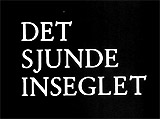

The Seventh Seal (1957, Swe.) (aka Det Sjunde Inseglet), 96 minutes, D: Ingmar Bergman
Swedish director Ingmar Bergman's influential psychological, fantasy-drama and art-house film was considered a landmark masterpiece. The classic, existential, thought-provoking film questioned serious religious issues concerning the existence of God, the afterlife, Death, and the loss of faith. The striking images throughout the film were due to the exquisite B/W cinematography of Gunnar Fischer. The film's title was derived from the Biblical Book of Revelation (chapter 8, verse 1). Many were aware that the film's stark imagery and basic plot became the subject of many comical spoof-parodies including Monty Python and the Holy Grail (1975, UK) (the flagellation sequence, the witch burning scene, and the mock-Swedish subtitles), Woody Allen's Love and Death (1975), Bill & Ted's Bogus Journey (1991) (with its Grim Reaper character and Bill & Ted's games with Death), and Last Action Hero (1993). During the Crusades and its time of medieval war, the Black Plague and misery, disillusioned and exhausted 14th century Swedish knight Antonius Block (Max von Sydow) after ten years of military service was finally returning home accompanied by his cynical squire Jöns (Gunnar Björnstrand). On their journey, the Knight and Squire made a side visit to a rural church, where painter Albertus Pictor (Gunnar Olsson) was drawing a series of frescos, including a painting of a fresco of the Danse Macabre (a dance of Death to the grave). The Knight engaged in a grim dialogue with a black-hooded and robed, white-faced Grim-Reaper figure of Death (Bengt Ekerot) who threatened his existence. The knight, who had mostly lost his faith, bargained with Death - an emissary from God - to play an allegorical game of Chess that would determine his fate - he would either win (and survive) or lose (and forfeit his life). If the game was lost, the Knight would be led away in a Dance of Death procession (danse macabre). In a continuing stark scene set on a desolate beach, a chess game was played between them throughout the film. The Knight engaged in a lengthy confessional in the church's chapel to a shrouded monk - when he delivered his deepest thoughts about wanting a sign from God of his presence, in order to help his belief. During the confessional, the Knight divulged his chess strategy to outwit Death during the game. But then in a startling revelation, it was shown that the monk was Death himself - who responded: "I'll remember that!"; the Knight replied: "You are a snake in the grass!" In the meantime, the Knight also encountered an itinerant acting troupe performing a Passion play. Within the caravan, he met a husband and wife pair named Jof (Nils Poppe) (a juggler) and Mia (Bibi Andersson) with their infant son Mikael (Tommy Karlsson). Their names resembled the names of the Joseph and Mary couple. Jof's simple faith enabled him to envision the existence of a human afterlife with a heaven and hell, while the Knight's visions were frustrating, elusive and not reassuring about a spiritual world after death. The philosophizing and skeptical Antonius felt tormented by an unseen God whom he thought was mocking him and remained hidden and vague. For him, life was meaningless and to be dreaded if there was no hope for life after death. However, in moments with Jof and Mia, the Knight became hopeful and enjoyed being alive; he found brief relief and peace during a fellowship picnic meal scene with the couple enjoying natural foods - wild strawberries and a bowl of milk. The dining sequence functioned as a symbolic, liturgical ceremony of the Eucharistic with bread and wine without supernatural overtones. Antonius offered the actors safe passage through a forested area to his castle. In stark contrast, Antonius's only witnessing of organized religion was to observe a procession of flagellants and the burning at the stake of a Witch (Maud Hansson) - an insane female accused of consorting with the Devil. As the film's chess game drew to a close, the Knight knocked the pieces over to buy more time, and to allow the young family he had met to outrun Death (the Black Plague). Death reset the chess board and stated emphatically: "No one escapes me" - Death would soon visit the Knight one last time. In the film's conclusion after reuniting with his wife Karin (Inga Landgré) and family during a final supper sequence, Death arrived to interrupt the Knight. He had just affirmed that he had performed a single, final comforting and redemptive good-will act ("one meaningful deed") and found some significant meaning in his life. Jof (with another paranormal experience) watched as the Knight and his followers-companions were led away over the hillside in a wild, solemn and macabre Dance of Death.

Sweet Smell of Success (1957), 96 minutes, D: Alexander Mackendrick
This taut, little-seen, menacing, late film noir classic was the first American film of Scottish director Alexander Mackendrick. Filmed on location in NYC, it was based on the novelette-short story by Ernest Lehman titled Tell Me About It Tomorrow, with a script by Clifford Odets and Lehman. In the film's opening, a large poster was viewed adorning the back of a truck: "GO WITH THE GLOBE, READ J.J. HUNSECKER - The Eyes of Broadway." It was presented with a rectangular logo that displayed the thick, horn-rimmed and spectacled eyes of the famous, domineering, power-mongering NY columnist J. J. Hunsecker (Burt Lancaster) for the New York Globe newspaper. The weasely, opportunistic, aspiring, two-bit, vicious and pandering press agent Sidney Falco (Tony Curtis) - a well-dressed, slimy, glamorous, manipulative pretty-boy Broadway agent, was forever struggling to place promotional items into Hunsecker's popular syndicated column in the newspaper, titled: "The Eyes of Broadway," in order to create media exposure for his show-biz clients. Falco had already failed dismally on his latest personal assignment ordered by the unscrupulous and overprotective Hunsecker - to disrupt, break up and destroy the romantic relationship between Hunsecker's 19 year-old younger sister Susan Hunsecker (Susan Harrison) and her blonde-haired boyfriend, up-and-coming jazz musician Steve Dallas (Martin Milner). Falco's efforts had backfired and the unyielding Hunsecker had denied any column space to Sidney's pandering attempts at publicity, and had exiled or banished Sidney from his sight. The first revealing view of the actual, beetle-browed, thick-spectacled, pallor-faced, power-mongering, crew-cutted NY columnist Hunsecker was in the "21" Restaurant where he regularly held court. Hunsecker delivered a brilliant, but vitriolic and foul description of lackey press agent Sidney Falco that ended with the famous line: "Match me, Sidney." In a short scene outside the restaurant when Hunsecker and Sidney observed a drunk being thrown out of Club Pigalle into the street and kicked, Hunsecker turned and sadistically smiled with an exultant grin: "I love this dirty town." During a memorable night scene, Hunsecker gazed out and towered over the skyline from his high-rise penthouse to survey the prone city below that he loved, possessed, and dominated like an imperious gargoyle. The unethical and immoral Falco, who was desperate to please Hunsecker (and knowing that the couple was closer to getting married), developed a new and sinister smear - that the bohemian musician Steve Dallas was a dope-smoking drug addict (with planted evidence of marijuana cigarettes) and a card-carrying Communist. But then, the duplicitous Hunsecker promised Susan, to get in her good graces, that he felt compelled to pull some strings to get Steve's job back after he was fired from the jazz club where his combo played - in order to regain the couple's confidence. In a famous line of dialogue, Hunsecker insulted Falco for his evil nature: "I'd hate to take a bite out of you. You're a cookie full of arsenic." Steve saw through the ploy and blamed Hunsecker for the smear, and bravely stood up to Hunsecker's manipulations of his romantic relationship with Susan that forbid them to be together. Hunsecker's over-reaching protectiveness toward his sister and insistent demands to break up her relationship led him to coerce Falco to hire a fat NYPD cop named Lieutenant Harry Kello (Emile Meyer) to brutally beat Steve up and falsely arrest him as a pot-smoker. Then, it was revealed that Hunsecker maintained a forbidding, secretive life as a repressed, asexual bachelor who exhibited unnatural 'incestuous' possessiveness for his sister Susan. Susan blamed Sidney and J.J. as responsible for the subsequent assault and false arrest of her boyfriend, and then threatened to commit suicide by hurling herself from her high-rise balcony, claiming that J.J. would then punish Sidney for allowing her to jump. At first, she threatened Falco: "You're gonna be the man who drove his beloved little sister to suicide" - and though Falco rescued her from suicide, a rigid-faced, menacing Hunsecker arrived home at that very moment and misinterpreted the situation, thinking that Sidney had attempted rape. The final scene was of Susan's vengeful departure to escape from her smothering, obsessed and 'incestuous' brother, and from the spineless, fast-talking Falco (both responsible for Steve's hospitalization). Before she left, she vilified her brother: "I'd rather be dead than living with you. For all the things you've done, J.J., I know I should hate you. But I don't. I pity you." She strode into the early morning sunlight at film's end, while a raging Hunsecker had Falco beaten up by Lt. Kello.
The Three Faces of Eve (1957), 91 minutes, D: Nunnally Johnson
Director/writer Nunnally Johnson's film-noirish, B/W psychological drama was an authenticated representation of an actual psychiatric case recorded in the 1957 book The Three Faces of Eve: A Case of Multiple Personality that was written by two Georgia psychiatrists of the Medical College (Corbett H. Thigpen and Hervey M. Cleckley) who assisted with the screenplay. Before their book's publication, the two doctors had also published a research article in 1954 about their therapeutic sessions with their multiple-personality patient "Eve." Best Actress-winning Joanne Woodward provided a tour-de-force performance in the role of the actual patient named Chris Costner Sizemore. Facing the camera in an empty movie theatre, the distinguished Alistair Cooke (as Himself) provided authenticity to the film with his opening narration, followed by additional off-screen commentary about the progression of the main character's illness: ("This is a true story. How often have you seen that statement at the beginning of a picture?... Well, this is a true story about a sweet rather baffled young housewife, who in 1951, in her hometown in Georgia, suddenly frightened her husband by behaving very unlike herself....in a literal and terrifying sense, inside this demure young woman, two very vivid and different personalities were battling for the mastery of her character. She was, in fact, a case of what is called 'multiple personality'"). In the film version set in Augusta, GA in August of 1951, a young, drab, withdrawn, plagued young housewife named Eve White (Joanne Woodward) was introduced. Eve's concerned husband Ralph White (David Wayne) became disturbed by his wife's aberrant behavior (i.e., buying flashy clothes) and physical symptoms (blinding headaches, memory lapses or amnesia, and blackouts) and reported the distressing symptoms to Dr. Curtis Luther (Lee J. Cobb). Eve apparently attempted to strangle the White's young daughter Bonnie (Terry Ann Ross) with a venetian-blind's cord in their living room, and Ralph had to throw her to the ground. In consultation with Dr. Luther, Eve claimed she was hearing one familiar but unrecognizable female voice ("She tells me to do things...To do things like leave Ralph, take Bonnie and run away. All kind of terrible things like that"). It was a symptom of her underlying mental illness. During Dr. Luther's treatment involving psychiatric therapy and hypnosis sessions with her, Eve (in addition to her normal timid Eve White personality) was found to have an additional or separate personality (or face) that emerged -- a fun-loving, flirtatious, seductive, party-happy, provocative, wild and immodest character known as Eve 'Black.' Completely out of character, Eve denied that she was married to the "jerk" Ralph, and referred to Mrs. White in the third person. Dr. Luther described his patient as having a multi-phasic personality disorder. By 1952, Eve was admitted to the hospital for treatment, and Dr. Luther confirmed his diagnosis of "multiple personality" to both Eve and Ralph. After about two weeks, it was decided that Eve could be discharged, since she wasn't considered a danger to herself or others. She would receive out-patient treatment, while Ralph moved by himself to Jacksonville, FL However, Eve's sporadic and unstable behavior, including provocative and seductive nightclub behavior with other men (and with Ralph himself) increased tensions and forced Ralph to ultimately divorce his wife. Dr. Luther was worried that both of Eve's two personalities were incapable of being 'normal.' In fact, he learned from Eve 'Black' that Mrs. White had considered suicide the night before by slitting her wrist with a razor blade. After further hypnosis, a third more stable, composed, mature and sophisticated matronly personality emerged known as 'Jane.' She claimed that she knew of her alter-egos (Eve 'Black' and Mrs. White) but was mostly unfamiliar with them. In the fall of 1953 during further treatment, Eve "White" (who appeared to be 'dying' or disappearing) reported instances of intense fatigue and other memory lapses. Eve (under hypnosis) recalled a traumatic event in her own childhood (Mimi Gibson as young Eve); during the memory, Eve cried out: "No, Mama! Mama, please don't make me!...She made me kiss her!" In a stunning flashback, the young girl described how her mother had forced her to kiss her grandmother in an open-casket during a funeral: ("You've got to kiss Grandma goodbye. Then you won't miss her so much if you kiss her goodbye, sugar pie. You know that"). It appeared that the terrifying incident was the trigger that had given birth to the personality of Eve "White." The recollection of her troubled past helped Eve to purge herself of her two negative 'Eve' selves, integrate her memories into one person ("Jane"), and cure her of the psychological disorder. In the film's concluding sequence set in 1955, two years after her breakthrough, Dr. Luther received a letter (in voice-over) from Jane about how she had formed a new family with Bonnie and a compassionate, understanding and loving man named Earl (Ken Scott), with the definitive statement: "Still no more Eve White and no more Eve Black."
Throne of Blood (1957, Jp.) (aka Kumonosu-jô), 105 minutes, D: Akira Kurosawa
Co-writer/director Kurosawa's dramatic samurai film was one of many interpretations or adaptations of William Shakespeare's tragedy-play Macbeth, now a tale of political treachery and murder set in 16th century feudal Japan (a time of dramatic Noh theater) instead of Medieval Scotland. This brilliant classic masterpiece, without using a single word of the Bard's famous dialogue, followed Orson Welles' Macbeth (1948), and came before Roman Polanski's Macbeth (1971) and Joel Coen's The Tragedy of Macbeth (2021), amongst others. In the plot, after victory in battle, Japanese general and warrior Taketoki Washizu (Toshiro Mifune) returned to the castle of reigning Lord Tsuzuki (Takamaru Sasaki) near the foggy and dense Spider's Web Forest. To Washizu's surprise, a premonition of his future - delivered by a mysterious evil Forest Witch or ghost-spirit in the forest just before his arrival at the castle - came true. It was predicted that Washizu would be named Lord of the Northern Garrison, and that he would soon replace Tsuzuki as Lord of Spider's Web Castle. Washizu's manipulative and ambitious wife Lady Asaji Washizu (Isuzu Yamada) spurred on the ascension of her husband to the throne by plotting the assassination of Tsuzuki. Washizu entered Tsuzuki's bedchamber and killed him in his sleep. The ruthless Lady Washizu cast blame on an innocent guard (who was quickly slain to assure his silence) to shield her treacherous husband's guilt. Washizu's actions were considered suspicious by Lord Tsuzuki's vengeful son Kuniharu Tsuzuki (Yōichi Tachikawa), but Washizu's faithful friend, General Yoshiaki Miki (Minoru Chiaki), remained uncertain. Miki's son Yoshiteru Miki (Akira Kubo) was chosen as Washizu's heir because he and Asaji had no child of their own. However, Lady Asaji soon after revealed that she was pregnant, necessitating the beheading of General Miki (his head was brought forward in a banquet scene), although Miki's son escaped. Problems multiplied for the increasingly paranoid Lord Washizu, when opposing forces were allied against him, and Lady Asaji's son was stillborn. Upon his return to the forest for further otherworldly advice, Lord Washizu was told that he wouldn't be defeated in battle until "the trees of the Spider's Web Forest rise against the castle" - an impossibility in Washizu's corrupted mind. The next day, however, his wife was found semi-crazed, in a catatonic trance, guilt-ridden and vainly attempting to wipe unseen blood stains from her hands, as a soldier reported that the cobweb forest's trees had indeed risen up to attack. In the film's conclusion, Lord Washizu made a memorable final stand against his own troops. A volley of arrows from his archers fired at him and resulted in his death on the throne, when one arrow lethally pierced his neck and chest. The approaching army of opposition forces revealed that they had cut trees in the forest during the night to create the illusion of their uprising.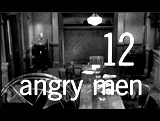

12 Angry Men (1957) (aka Twelve Angry Men), 96 minutes, D: Sidney Lumet
Sidney Lumet's debut directorial film, a taut courtroom drama, was based on Reginald Rose's television play. In a hot summer courtroom in NYC after the trial, instructions by a Judge (Rudy Bond) were given to the jury, concerning the case of an 18 year-old, slum-dwelling Puerto Rican/Latino defendant (John Savoca), held on charges of murdering his abusive, ex-con father with a switchblade knife - he faced the electric chair if convicted. He had been defended by a poorly-paid, inept public defender. The entire film consisted of the deliberations of twelve male individuals (each un-named but with a number) held in a swelteringly-hot, bare-walled claustrophobic jury room, punctuated by flashbacks about the case and trial, to decide the fate of the minority defendant. They had been given instructions from the judge about 'innocent until proven guilty beyond a reasonable doubt.' One female witness testified that through her bedroom window and a passing elevated train, she had seen the murder. Another elderly witness claimed he heard the defendant say: "I'll kill you" - after which he heard the body drop and saw the defendant running down the stairs. As evidence, the long switchblade murder weapon was similar to the one the defendant had purchased. On the witness stand, the defendant's alibi was weak - he said he was at the movies during the night before returning to the scene of the crime, but couldn't recall the movies that he had seen. The case required a unanimous vote ("beyond a reasonable doubt") of 12 jurors to convict, and to send the defendant with a mandatory death sentence to the electric chair. It was a seemingly open-and-shut case. After the first rapid jury vote, it was eleven to one for conviction. Juror # 8 (Henry Fonda), an architect, was the sole doubting and dissenting vote. The tempers, prejudices and personalities of the cranky, smoking men were displayed as they examined the evidence and deliberated their verdict. After considerable deliberations and discussion, including # 8's display of an identical switchblade knife he had bought, a second vote was taken - # 8 was joined by Juror # 9 (Joseph Sweeney) - and now it was ten to 2. Juror # 8 began to poke holes in the flimsy evidence, the inconsistent testimony of the unreliable witnesses, and the prejudices of some of the other jurors, especially Juror # 10 (Ed Begley). For one thing, the old male witness probably couldn't have heard the defendant yell at his father as the noisy six-car train passed on the tracks. And the elderly man, who was lame, couldn't have walked from his bedroom to his door in 15 seconds as he claimed. The woman who said she saw the crime through the passing train was not wearing her glasses. Eventually, revotes dwindled down the number of those calling for conviction. Only one Juror, # 3 (Lee J. Cobb) remained defiant, and he too changed his vote. The defendant was acquitted of the crime.

Wild Strawberries (1957, Swed.) (aka Smultronstället), 91 minutes, D: Ingmar Bergman
Ingmar Bergman's allegorical, deeply-emotional road film was about an elderly man's look back at his past, told through a flashback structure. The film was literally titled "the wild strawberry patch" referring to the wild, unburdened and free strawberries growing and simply existing in a hidden and secret place in one's past that could be revisited, hopefully without regret or pain. At his desk, Professor Isak Borg (legendary silent film actor and Scandinavian director Victor Sjostrom), a 78 year-old widowed, grumpy, wealthy, retired medical professor and doctor described his isolated and lonely life (in voice-over). Early the next morning, Isak experienced an expressionistic nightmarish dream sequence (also in voice-over) on a deserted, white-walled city street in Stockholm - with images of death. On the empty streets, he saw a clock without hands, a collapsing faceless figure, and his own corpse in a spilled coffin. The lonely, melancholic professor reassessed his heartless, constrained and cold life during the film's 375-mile car road trip from Stockholm to his former university in Lund. There at 5:00 pm, he was to receive an honorary degree ("Jubilee Doctor") in the University's Cathedral 50 years after he had earned his doctor's degree. His visiting, pregnant daughter-in-law Marianne (Ingrid Thulin), unhappily estranged but married to his sole son - middle-aged physician Evald (Gunnar Björnstrand) who lived in Lund, impulsively asked to join him. During the journey, she explained her and her husband's reasons for disliking Isak - their frustration with him was partially due to the fact that he was "filthy rich" and didn't need money and still demanded payback of their loan. She also mentioned his selfish, ruthless, egotistical and uncaring nature. In a series of episodic sequences, he revisited (both in his flashbacked imagination and literally) many of the landmarks of his past. Their first stop was his family's summer home where he lived for the first 20 years of his life with nine other siblings. This was the location of the titled wild strawberry patch. He jealously recollected watching his onetime, long-departed sweetheart cousin Sara (Bibi Andersson) with Isak's own irresponsible, misbehaving, "good-for-nothing" brother Sigfrid (Per Sjöstrand). He was reminded that she had broken his heart when she later married Sigfrid and had 6 children. Three young hitchhikers joined them - two young men Viktor (Björn Bjelfvenstam) and Anders (Folke Sundquist), and Sara (also played by Bibi Andersson). Both Sara characters were caught between two lovers who were competing for her affection. Enroute after a brief lunch, Marianne and Isak stopped at the home of Isak's elderly, 96 year-old cold-hearted mother Mrs. Borg (Naima Wifstrand). Isak was her sole surviving son of ten children. She showed Isak a box of keepsake mementos, including an old discarded doll, toys and her husband's gold pocket watch with no hands (the same one seen in his opening dream sequence). She provided hints into why people perceived her son as similarly-cold; she even openly admitted: "I have felt cold all my life." During the remainder of the trip, Isak napped and dreamt of being with Sara in the strawberry patch once again. While napping, Isak was also forced to face his past and remember that his deceased wife Karin (Gertrud Fridh) was very unhappy in their marriage and despised him. He listened as she blamed their problems on Isak's "cold as ice" callous and passive detachment from her and life. Also, while sitting in the car with Isak, Marianne explained to him the reason for her disintegrating marriage to his melancholy and sad 38 year-old son Evald. When she had told Evald that she was pregnant, he said that he didn't want the child. Marianne was worried about Isak's emotional detachment, with fears for her own pregnancy and future life with her husband Evald. Nonetheless, she vowed to Isak that she would have the child. In the film's satisfying, well-deserved and peaceful conclusion with some elements of hope and redemption, after Isak was awarded a degree at the ceremony, he appeared to come closer to his daughter-in-law Marianne and her husband Evald. He suggested cancelling Evald's long-standing enormous debt to him, and helped to bring them together and reconcile their marriage. Furthermore, Isak experienced one more childhood dream to calm him. His memories would no longer torment him, but provided moments of pleasant nostalgia. His last uplifting dream was of a family picnic by a lake at his summer home. Sara ran up to him and told him: "There are no wild strawberries left."


Witness For The Prosecution (1957), 114 minutes, D: Billy Wilder
Co-writer and director Billy Wilder's brilliant film had crisp dialogue, a complicated and intriguing plot, unique characters and excellent acting performances. It was a convoluted, twisting courtroom drama-mystery adapted from Agatha Christie's classic four-character short story "Traitor's Hands," first printed in 1925 in the British magazine Flynn's, and then published in the 1930s and 1940s in both the UK and US as "The Witness for the Prosecution." It then became a celebrated 1953 stage play and murder mystery (in London and on Broadway). The film told about an aging, distinguished, near-retirement age London barrister Sir Wilfrid Robarts (Charles Laughton), with his overbearing housekeeper/nurse Miss Plimsoll (Elsa Lanchester, Laughton's real-life wife) tending to his near-failing health for a weak heart. The intelligently clever and incorrigible attorney was asked by solicitor Mr. Mayhew (Henry Daniell) to take on a perplexing case, the defense of the prime suspect - an unemployed, American expatriate inventor named Leonard Stephen Vole (Tyrone Power in his final film role). He was charged with the murder of wealthy widow Emily Jane French (Norma Varden), in order to inherit her property (80,000 pounds). The testimony -- and true identity -- of the mysterious, beautiful German-born 'wife' of the accused, Christine "Helm" Vole (Marlene Dietrich), held the key to solving the case involving marital infidelities and deceit. She was her husband's only alibi - but she could not, as the defendant's wife, be considered a credible witness. However, she WAS called as a 'witness for the prosecution' to damningly testify against him and cold-heartedly betray her husband. On the stand, she admitted that: (1) she wasn't really legally married to Leonard (and could therefore testify against him), (2) she was forced by him to provide a false alibi, and (3) her husband had admitted the murder to her, after returning home with blood on his clothes. When a mysterious Cockney woman (also Dietrich) called Sir Wilfrid claiming that she had surprise information to help his client, the film set up the twist ending. She offered to supply the barrister with love letters that the perjuring Christine had written to a mysterious lover named Max. When the trial resumed, Sir Wilfrid confronted Christine with the letters (so she could get rid of Leonard and be with another man) to prove that she had lied. Having proven Christine to be a liar and unreliable witness, Leonard was declared 'not guilty.' After Leonard had been acquitted, Christine revealed that she was disguised as the Cockney woman who had devised the ploy of love letters to get Vole acquitted. Only by being an entirely uncredible witness could she get her husband declared innocent. The defendant had obviously been guilty all along, and had committed the crime. He also declared that he was unfaithful and philandering with Diana (Ruta Lee), who arrived in the courtroom to run away with him. Then, with furious and jealous anger, Christine shockingly stabbed him to death for his double-crossing philandering! This climactic murder was followed by Sir Wilfrid's classic line when he corrected his nurse Miss Plimsoll about the killing: "Killed him? She executed him." Sir Wilfrid would now serve as Christine's defense lawyer.